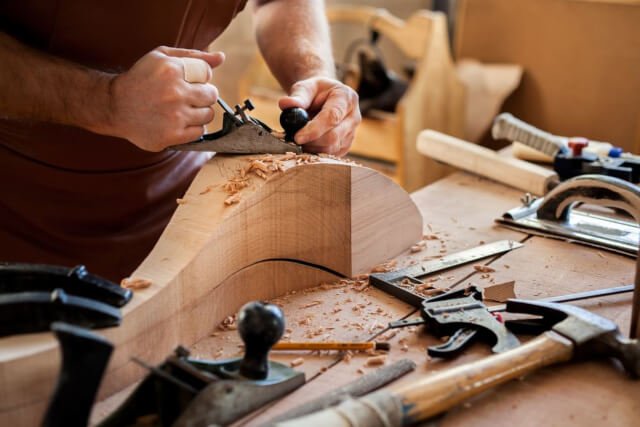Super glue is a popular adhesive known for its strong bond and quick drying capabilities. When it comes to woodworking, the use of super glue has become a topic of interest for many enthusiasts and professionals alike. In this article, we will explore the question: does super glue work on wood in woodworking projects?
Understanding the types of super glue available and their effectiveness on wood is essential for any woodworking project. Factors such as the type of wood, surface preparation, and application technique can all influence the success of using super glue in woodworking.
In this section, we will delve into the different types of super glue and their impact on wood, as well as discuss the factors to consider when using this adhesive in woodworking projects. Whether you are a beginner or experienced woodworker, understanding how to properly apply super glue to wood can make a significant difference in the outcome of your projects.
Understanding the Types of Super Glue and Their Effectiveness on Wood
Super glue, also known as cyanoacrylate adhesive, is a popular choice for bonding wood in woodworking projects due to its quick-drying and strong adhesive properties. But not all super glues are created equal when it comes to their effectiveness on wood. Understanding the different types of super glue and their specific applications in woodworking is crucial for achieving successful results.
There are several types of super glue available on the market, each with its own set of characteristics and intended uses. When it comes to wood, the most commonly used types of super glue include:
- Cyanoacrylate: This type of super glue is suitable for bonding porous materials like wood, as it forms a strong bond when it comes into contact with moisture in the air or on the surface of the material.
- Gel: Super glue in gel form is ideal for vertical or overhead applications on wood, as it has a thicker consistency that prevents it from running or dripping during the bonding process.
- Wood-specific: Some manufacturers produce super glue specifically formulated for bonding wood surfaces, offering enhanced adhesion and resistance to moisture for woodworking projects.
To determine which type of super glue works best on a particular woodworking project, consider factors such as the type of wood being used, the intended use of the bonded surface, and environmental conditions like temperature and humidity that may affect the adhesive strength.
When using super glue on wood in woodworking projects, it’s important to follow certain guidelines to ensure proper application and maximize its effectiveness. Here are some steps to consider when applying super glue to wood:
- Prepare the wood surfaces by ensuring they are clean, dry, and free from any dust or debris.
- Apply a small amount of super glue to one of the surfaces being bonded, taking care not to over-apply.
- Press the two surfaces together firmly and hold them in place for several seconds to allow the bond to form.
- Allow sufficient time for the super glue to fully cure before handling or subjecting the bonded surfaces to stress or load.
By understanding how different types of super glue work on wood and following proper application techniques, woodworkers can achieve durable and reliable bonds in their woodworking projects.
Factors to Consider When Using Super Glue on Wood
When using super glue on wood in woodworking projects, there are several key factors to consider in order to ensure a strong and long-lasting bond. Understanding these factors is crucial for achieving the best results and preventing any potential issues with the adhesion.
Wood Type and Porosity
The type of wood being used will have a significant impact on how well super glue adheres to it. Different types of woods have varying levels of porosity, which can affect the penetration and bonding ability of the super glue.
Hardwoods such as oak or maple may require a different approach compared to softwoods like pine or cedar. It’s important to take into account the natural oils, moisture content, and grain structure of the wood when choosing the right type of super glue for the job.
Surface Preparation
Properly preparing the surface of the wood is essential for ensuring a strong bond with super glue. Before applying the adhesive, it’s important to make sure that the wood is clean, dry, and free from any dust, dirt, or debris. Sanding the surface can also help improve adhesion by creating a rough texture for the super glue to grip onto.
Clamping Pressure and Curing Time
Applying adequate pressure while the super glue sets is crucial for achieving a strong bond between pieces of wood. Depending on the specific type of super glue being used, it may require different clamping pressures and curing times. Following the manufacturer’s instructions for application and allowing sufficient time for the adhesive to fully cure is essential for ensuring optimal bonding strength.
Considering these factors when using super glue on wood in woodworking projects can help achieve reliable and durable bonds between wooden pieces. By understanding how different types of wood interact with various super glues and following proper application techniques, woodworkers can effectively incorporate this adhesive into their projects with confidence.
Steps for Properly Applying Super Glue to Wood in Woodworking Projects
Super glue is a versatile adhesive that can be used in woodworking projects to bond wood pieces together. When working with super glue on wood, it is important to follow the proper steps for application to ensure a strong and durable bond. Here are the steps for properly applying super glue to wood in woodworking projects:
1. Prepare the surfaces: Before applying super glue, it is crucial to prepare the surfaces that will be bonded together. Make sure the wood surfaces are clean, dry, and free from any debris or dust. Sanding the surfaces may also improve adhesion.
2. Apply the super glue: Once the surfaces are prepared, apply a small amount of super glue to one of the wood pieces. It is essential to use the right amount of glue – too little may result in a weak bond, while too much may cause excess glue to squeeze out when pressure is applied.
3. Press and hold: After applying the super glue, immediately press the two wood pieces together firmly. Hold them in place for several seconds to allow the adhesive to set and create a strong bond.
4. Allow time for curing: While super glue sets quickly, allowing sufficient time for curing is important for maximum strength. Avoid moving or stressing the bonded pieces until the adhesive has fully cured.
By following these steps, you can effectively use super glue on wood in your woodworking projects to create durable and long-lasting bonds.
Common Mistakes to Avoid When Using Super Glue on Wood
When it comes to using super glue on wood in woodworking projects, there are several common mistakes that can compromise the effectiveness of the adhesive. One of the most common mistakes is not properly preparing the wood surface before applying the super glue. It is important to ensure that the wood is clean and free of any debris or moisture that could interfere with the bonding process.
Another mistake to avoid is using too much or too little super glue. Using excessive amounts of super glue can lead to messy, unsightly drips and a weaker bond, while using too little may result in inadequate adhesion. Finding the right balance is key to achieving a strong and clean bond when working with wood and super glue.
Furthermore, failing to clamp the bonded pieces together firmly during the drying process can also lead to weak bonds. Proper clamping is essential for allowing the super glue to cure and create a strong hold between the wood pieces. Without adequate pressure, the bond may not be as secure as it should be.
| Mistake | Effect |
|---|---|
| Not Preparing Wood Surface | Compromise bonding process |
| Using Too Much or Too Little Super Glue | Weaker bond or inadequate adhesion |
| Failing to Clamp Firmly | Weak bonds |
Tips for Maximizing the Adhesive Strength of Super Glue on Wood
When it comes to using super glue on wood in woodworking projects, maximizing the adhesive strength is essential for ensuring a strong and durable bond. Super glue, also known as cyanoacrylate adhesive, can be highly effective when used correctly on wood. However, there are some tips and techniques that can help maximize its adhesive strength.
One important factor to consider when using super glue on wood is the type of super glue being used. There are different viscosities and formulations of super glue available, and some may be more suitable for use on wood than others. For example, medium or thick viscosity super glues tend to work better on porous surfaces like wood, as they have greater gap-filling capabilities.
Another tip for maximizing the adhesive strength of super glue on wood is to ensure that the surfaces being bonded are clean and free of any contaminants. Wood surfaces should be smooth and dry before applying the super glue. Any oil, moisture, or dust on the surfaces can interfere with the bonding process and weaken the adhesive strength.
Additionally, clamping the bonded surfaces together can help enhance the adhesive strength of super glue on wood. When working on woodworking projects, using clamps to hold the pieces in place while the super glue sets can help create a stronger bond.
This also helps prevent any movement or shifting of the pieces during the bonding process, which could compromise the strength of the bond. Following these tips can help maximize the adhesive strength of super glue on wood in woodworking projects, leading to successful and long-lasting bonds in your creations.
Alternative Wood Adhesives for Woodworking Projects
Super Glue is a popular adhesive used in woodworking projects due to its quick-drying and strong bonding properties. However, there are alternative wood adhesives that can also be effective in woodworking. One of the main alternatives to Super Glue for wood is epoxy, which is a versatile adhesive that can bond different types of wood and can also be used as a filler. Epoxy is especially useful in woodworking projects that require filling gaps or cracks in the wood.
Another alternative to Super Glue is polyurethane glue, which is a waterproof adhesive that expands as it dries, filling voids and creating a strong bond. Polyurethane glue is particularly effective for outdoor woodworking projects or for joining non-wood materials to wood. It does not require the same level of precision as Super Glue when applying, making it easier to work with.
In addition to epoxy and polyurethane glue, traditional wood glue remains a popular choice for woodworking projects. This type of adhesive provides a strong bond between pieces of wood and is easy to sand down once dried. Wood glue also allows for some flexibility when working with different types of wood, making it versatile for various woodworking applications.
| Adhesive Type | Benefits |
|---|---|
| Epoxy | Versatile, can be used as filler, strong bonding properties |
| Polyurethane glue | Waterproof, expands as it dries, fills voids |
| Wood glue | Strong bond between different types of woods |
When choosing an alternative wood adhesive for woodworking projects, it’s important to consider the specific requirements of the project and the properties of each type of adhesive. Each alternative has its own advantages and limitations depending on factors such as climate exposure, type of wood being used, and drying time. Ultimately, selecting the right adhesive for a woodworking project involves understanding the unique qualities and benefits offered by each type.
Real-Life Examples of Successful Woodworking Projects Using Super Glue
DIY Home Repairs
One of the most common real-life examples of successful woodworking projects using super glue is in DIY home repairs. Whether it’s fixing a broken chair leg or repairing a wooden picture frame, super glue can be a quick and effective solution for small woodworking projects around the house. The fast-drying nature of super glue makes it perfect for these types of repair jobs, allowing homeowners to complete the project in no time.
Furniture Making
Many professional woodworkers also use super glue in their furniture-making projects. When working on intricate designs or detailed woodwork, super glue provides the strength and precision needed to create high-quality furniture pieces. It can be used to bond different types of wood together, ensuring a durable and long-lasting final product. Additionally, super glue’s fast setting time allows woodworkers to move on to the next steps of their project without having to wait for long drying times.
Wooden Crafts and Artwork
Artists and crafters who work with wood also find success using super glue in their projects. Whether it’s assembling small wooden pieces for intricate crafts or creating stunning artwork from various types of wood, super glue is a versatile adhesive that can handle the demands of artistic woodworking. With its ability to bond quickly and securely, artists are able to bring their creative visions to life without worrying about weak joints or gaps in their wooden creations.
Conclusion
In conclusion, the use of super glue in woodworking can be effective when used properly. It offers a quick and strong bond that can be beneficial for various woodworking projects. However, it is important to consider the type of wood and the type of super glue being used to ensure the best results. Factors such as temperature, moisture, and clamping pressure should also be taken into account when using super glue on wood.
When applying super glue to wood in woodworking projects, it is essential to follow the proper steps for maximum effectiveness. This includes preparing the surfaces, applying the right amount of glue, and ensuring a tight bond by using clamps or other methods. Additionally, avoiding common mistakes such as overapplying or underapplying the adhesive and not allowing enough drying time is crucial for successful use of super glue on wood.
While super glue can be a great option for woodworking projects, there are also alternative wood adhesives available that may better suit certain needs. It is important for woodworkers to consider their specific project requirements before choosing the best adhesive for their needs. Overall, when used correctly, super glue can be a valuable tool in woodworking for creating strong and reliable bonds between wood pieces.
Frequently Asked Questions
Is Super Glue Better Than Wood Glue for Woodworking?
Super Glue and wood glue both have their own strengths when it comes to woodworking. Super glue is great for small, delicate projects or for bonding non-porous materials, but wood glue is better for larger, heavier pieces of wood.
Will Super Glue Stick Wood to Wood?
Yes, super glue can stick wood to wood due to its strong adhesive properties. It can be particularly useful for bonding small pieces of wood together or for filling in gaps in joints.
What Super Glue Do Woodworkers Use?
Many woodworkers use cyanoacrylate-based super glues for their woodworking projects. These types of super glues are known for their quick drying time and strong bond, making them suitable for a variety of woodworking applications and materials.
Some prefer to use specialized wood glues that are designed specifically for bonding wooden surfaces together, depending on the specific needs of the project.

Hi everyone! I’m a woodworker and blogger, and this is my woodworking blog. In my blog, I share tips and tricks for woodworkers of all skill levels, as well as project ideas that you can try yourself.





